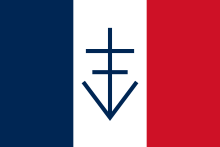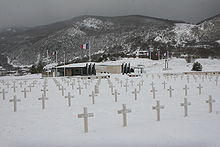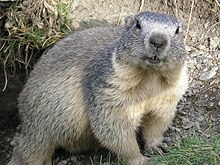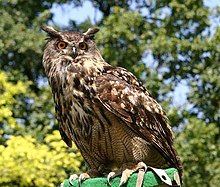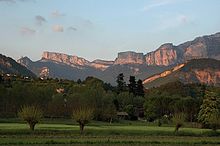Vercors
The Vercors is a mountain range bounded by deep valleys in the extreme west of the French Alps . It has an extension of about 30 by 40 kilometers and several two thousand meter peaks (summit heights up to 2350 m). Since it rises sharply on all sides, it could only be made accessible to road traffic in the 20th century, sometimes with galleries blasted into the rock. Due to the limited usability, the Vercors is the largest nature reserve in France with 170 square kilometers .
Origin of name
The origin of the name Vercors is still controversial in toponomics today. The assumption that it is linked to the French word vert (green) is not tenable, since Pliny the Elder already used the term Vertamocorii in the 1st century ; viridis , the Latin name for green, is not included there. It is believed that Vertamocorii can be traced back to Gallic origins. The Gallic ver stands for "up high" (see. Old Irish for "over, over ... also" proto-Germanic * about , Sanskrit Upari , ancient Greek. Hyper , lat. Super ) -tamo- is a Superlativsuffix (see. Sanskrit -tama- , Latin op-timus “the best”, ul-timus “the outermost”, in-timus “the innermost”), and finally corios is the term for “troop, army” (cf. old Irish cuire and ancient Germanic * harjaz ). So there could be two possible interpretations for the name: "Territory of the troops from the highlands" or "Territory of the superior, outstanding warriors".
geography
The Vercors is located in south-eastern France , in the departments of Isère and Drôme (Region Auvergne Rhône-Alpes of Greater Dauphiné ) between the cities of Grenoble and the . The mountain range is bounded by the Isère , Drac and Drôme rivers. East of the massif is the Trièves valley and the mountain town of La Mure . The closest major city to the west is Valence , near the confluence of the Isère and Rhône rivers.
As the southernmost element of the five Chaînes Subalpines Septentrionales ( Haut-Giffre , Aravis , Bauges , Chartreuse , Vercors) the Vercors is a self-contained massif with a long, north-south-facing, hilly high valley. The Grand Veymont is the highest peak of the massif at 2,341 meters.
Significant mountains from north to south:
- Moucherotte (1901 m)
- Roc Cornafion (2049 m)
- Arêtes du Gerbier (2109 m)
- Grande Moucherolle (2284 m)
- Petite Moucherolle (2156 m)
- Tête des Chaudières (2029 m)
- Rochers de la Balme (2063 m)
- Sommet de Malaval (2097 m)
- Grand Veymont (2341 m)
- Mont Aiguille , (2086 m)
- Pié Ferré (2041 m)
Geological evolution

Mesozoic
At the beginning of the Mesozoic Era (approx. 250 million years ago), the "Age of the Dinosaurs ", the majority of the earth's land area consisted of a single supercontinent : Pangea , with Laurasia ( North America , Northern and Central Europe, largest part of Asia ) as the northern part and Gondwana ( South America , Africa , India , Australia , Antarctica ) as the southern part. These two parts opened like scissors to the east and in this opening lay the great ocean of Tethys . The western part of this ocean is the cradle of today's Vercors. Up to 6000 meters of marine sediments have been deposited in this area .
In the Mesozoic Era, Pangea fell apart completely. Laurasia rotated clockwise south and Africa shifted north. The scissors on the Tethys slowly closed. During the Jurassic (approx. 200 to 135 million years) there was a deep sea basin in the Vercors area. 2000 meters of deep sea clays and marl accumulated. The deep-sea clays are mainly open as Terres Noires, black, fine-leaved layers. The basin merged into a coastal region northeast of the Vercors, for example in the Isère Valley. In the Lower Cretaceous Period (approx. 135-100 million years) the coastline had pushed further to the southeast. Here, marl and limestone banks alternated between deposits , with the marl indicating cooler or deeper water and the limestone indicating warmer or shallower water. The limestone is a solid rock , while the marl is a soft and crumbly sedimentary rock. This puff pastry-like alternation is a delightful sight in the striped sediment outcrops. The area around the Vercors was no longer deep sea . Finally, a shallow, warm lagoon with very powerful reefs spread out, which today form massive white cliffs up to 300 meters high and give the Vercors its unique charm. In the Upper Cretaceous Period (approx. 100–65 million years), strips of land lifted out of the sea as a result of the subduction of the Tethyan ocean crust under the continental crust . Alternately, parts of the Vercors fell dry and were covered again by the shallow sea.
Tertiary
In the Tertiary (approx. 65 to 2 million years ago) the African continent moved so close to Central Europe that the Alps rose and with them the Vercors. While the crust was bulging up, erosion began. Sand and mud were dumped. In the Miocene , a wide rift opened in the west, in the area of the foothills of the Alps and today's Rhône valley, due to the expansion processes in the continental plate, which resulted in a lowering of the land mass. The sea flooded the area one last time and mainly deposited debris such as sand and rubble . Eventually the Vercors got its present form. The ice ages carved out the valleys into wide troughs. The water gnawed at the limestone layers, cracks and crevices formed. Rivers quickly cut these fissures and created deep ravines. Numerous stalactite caves were created by collapsing cavities in the limestone.
Today's appearance
Today's surface of the earth is strikingly shaped by parallel folds in north-south direction, which run through the entire western pre-Alps . They emerged when Belledonne and Pelvoux rose steeply in the neighboring massifs cristallins externes (outer crystalline massifs) . This pushed the sediments together to form the parallel folds of today's Chaînes Subalpines , the subalpine chain. Some of the folds were overturned, so that today older layers can be found over younger ones.
These folds are subject to a constant process of erosion . The remains of the high parts of the folds ( anticlines ) form the mighty mountain ranges of the Vercors. Above all, the exposed reef limestones rise up steeply and show cliffs that drop off steeply up to 300 m. They are rich in fossils , especially ammonites and early marine snails . In the crumbly marl layers in between there are pyritized ammonites and belemnites . In the fold valleys ( synclines ), erosion is less advanced. The sandy deposits of the Miocene and the shallow-water limestones of the Upper Cretaceous have been preserved here.
history
Settlement from early history to the Middle Ages
Traces of the Neanderthals suggest that the cave entrances (for example the choranche ) and overhanging rocks were used as shelters as early as the Middle Paleolithic about 70,000 years ago . Since then, radical changes in the climate have changed the landscape and wildlife on several occasions.
The Neanderthals used flint tools of the Levallois technique . With the help of these tools, they had to deal with cave bears and cave lions and hunt bison , deer and ibex. During the Würm Ice Age , about 70,000 to 35,000 years BC. BC, the entire Alps including the Vercors were glaciated. Towards the end of this period, however, the colonization of Europe by modern humans (Homo sapiens) took place with the simultaneous displacement of the Neanderthals. Modern man first settled on the plains in southern and central France, from around 11,000 BC. Also in the Vercors and in the Alpine valleys. The climate was still cold and harsh, the landscape a cold steppe with few trees. The plains ( Saint-Nazaire-en-Royans and Romans ) remained the main living and hunting areas , where reindeer, horse and bison were the most important sources of meat and also the motifs for bone engraving in addition to small animals. In the Vercors, ibex ( La Chapelle-en-Vercors ) and trout were the main prey, while the marmots had to provide warm furs against the still prevailing cold. Firestone tools made with great craftsmanship, as well as bone tools were the necessary weapons for spears and harpoons, scrapers and scrapers for meat and hide processing, but were also used as additions, for example in a Magdalenian grave near Saint-Agnan-en-Vercors .
About 9000 years BC The still ongoing warm period began . The landscape changed again very quickly and strongly, pine and birch forests replaced the cold steppe, the number of hunted animals declined, the ibex migrated to higher, hard-to-reach high mountain regions, herds of reindeer and horses moved north. Man had to adapt his way of life, the Magdalenian passed into Azilia . The now more isolated animals were hunted with a bow and arrow. The caves were no longer inhabited, the camps had to follow the hunted animals, the flint tools were transformed into microliths about one to three centimeters in length that could be used universally as cutting tools or as components of weapons (spear and bow tips).
The domestication of the dog and the slow transition from the purely nomadic hunter to the more sedentary shepherds and farmers also fell during this period . In the Vercors, as in the Alps in general, this is approximately from 4000 to 2000 years BC. To apply. Axes for larger clearings, ceramic vessels for storing the harvest, more permanent settlements for a growing population characterize the Middle Neolithic . The technique of flint processing remains in erzarmen Vercors, is high (scythes, sickles, jewelry) and quantitative ( Export from the plateau of Vassieux-en-Vercors ) expanded. It was not until the end of the Bronze Age (approx. 1750–750 BC) that there was regional metal production, especially arrowheads and jewelry, but at the same time the processing of flint remained an important branch of the economy. The Vercors society, which is increasingly focused on sedentarism , farming and shepherd work, had pigs, cattle and sheep as pets, although hunting continues to play an important role in the supply of meat. Ever larger clearings in the Vercors as well as the discovery of numerous mills and mortars indicate a strong expansion of the grain industry, but also a growing population.
Around 750 BC In BC, equestrian tribes from the north invaded the Vercors area with iron weapons (grave near Saint-Thomas-en-Royans ).
The climatically mild lowlands around the Vercors were a preferred habitat for the Romans . They mined limestone on the high plateaus for monuments and magnificent buildings. A quarry is still preserved, as is a section of the Roman road .
A worsening climate made cattle breeding more difficult, sheep and goats became the most important livestock. Germanic invasions at the end of the Western Roman Empire made the Vercors an area of protection and retreat in which culture and society survived beyond the Middle Ages without major changes. Remains of fortifications suggest that the trade route between Grenoble and Die was controlled.
middle Ages
Little has been preserved about the Middle Ages in the mountain range. Due to the lack of central power, several local rulers seem to have formed at first, who reinforced their claim with relatively primitive fortifications. These were probably created primarily for the purpose of, perhaps even predatory, control on narrow trade routes. Monks settled in the high areas of the Vercors, who mainly made their living with agriculture and cattle breeding. Eventually the Lords of Sassenage were able to rule over a large part of the Vercors.
Protestantism
In the 16th century, Protestantism found a strong following in the Vercors area, which resulted in several bloody civil wars . The Edict of Nantes (1598) then made possible a peaceful coexistence of Catholics and Protestant Huguenots . With his revocation, most of the Huguenots fled to Switzerland. But some stayed and formed the resistance.
The partisan republic République du Vercors during the Second World War
During the German occupation in World War II , Vercors was an important center of the Resistance , as a retreat, training, military hospital ( Grotte de la Luire ) and supply area for an active group of Maquisards who started partisan attacks from Vercors , especially in the Rhône Valley and in the Alps organized. On February 1, 1944, among other things, the Vercors fighters were united to the Forces françaises de l'intérieur (FFI); according to one (in retrospect: greatly exaggerated) assessment by Eisenhower , they had a combat value of 15 divisions. The Allies and General de Gaulle assured the Vercors that they would deploy airborne troops here and supply the fighters with weapons, ammunition and important goods via an airlift . This promise was given very vaguely, but the resistance fighters trusted this support and after June 6, 1944 proclaimed the République du Vercors . Over 4000 fighters rallied; the partisan struggle was to become an open, armed insurrection.
The Allied promise was not kept: No additional troops were sent, there was no airlift supply, the Vercors fighters were isolated and on their own. Heavy weapons were completely absent.
The threat to the stage from an open, armed uprising from Vercors was unsustainable for the Wehrmacht ; even in July 1944, a month before the liberation of Grenoble by the Allies attacked on July 21, two from mountain infantry existing combat groups of the 157th Reserve Division ( Group Schwehr and group Seeger ) the rock passes to and from the south penetrated an armored battle group of 9 Panzer Division ( Zabel Group ) in front. In the heart of the plateau two companies of paratroopers ( group Schäfer ) landed with gliders ( DFS 230 ). They were not Waffen-SS troops (as was assumed for a long time). The paratroopers in particular, who were reinforced by around 50 soldiers from an eastern battalion from July 23 , committed several war crimes under SS-Obersturmbannführer Werner Knab . The villages of Vassieux-en-Vercors and La Chapelle-en-Vercors as well as numerous individual farmsteads were almost completely burned down, and over 70 civilians were executed as reprisals in Vassieux. Prisoners were resistance fighters as insurgents shot. A total of 639 resistance fighters and 201 civilians died . The German losses amounted to about 100 men. During the conquest of the Saint-Martin cave hospital ( Grotte de la Luire ) on July 27, 19 wounded resistance fighters were murdered, two doctors and a priest were executed in Grenoble and two nurses were deported to the Ravensbrück concentration camp (one of the two, Rosine Cremieux, experienced this The end of the war and the liberation, as she fled and was kept hidden by a former communist in Hainsberg near Freital ). An American commando soldier, who was also captured , was spared, although the commando would have executed him. Most of the resistance fighters were able to retreat to the inaccessible forest of Lente. The events of this resistance are documented in the Musée de la Résistance in Vassieux-en-Vercors with the Cimetière National du Vercors cemetery for 186 victims of the Resistance, as well as in the Resistance Museum in Grenoble .
Olympic games
The northern part of the Vercors Mountains was the venue for numerous sporting competitions during the 1968 Winter Olympics . For this purpose the access roads were expanded and new sports facilities were built. In Autrans the competitions took place in cross-country skiing and biathlon instead; In addition, the Le Claret ski jump was built there . Another ski jump was built in Saint-Nizier-du-Moucherotte , but the Dauphine ski jump has been out of order since 1990 and is being left to decay. Villard-de-Lans was the location of the Olympic toboggan run .
Vercors reserve
In 1970, the French state founded the Vercors Regional Nature Park ( Parc naturel régional du Vercors in French ) together with the regionally affected municipalities , which roughly corresponds to a German landscape protection area. In 1985, with 170 square kilometers, the largest nature reserve in France, the Réserve naturelle des Hauts plateaux du Vercors, was placed under protection. It includes the eastern part of the central main valley and above all the steep eastern edge of the Vercors with forests, high meadows, limestone plateaus and steep slopes.
Around 1,800 plant species thrive in the regional park , including 60 orchids . 135 species of birds and 65 species of mammals have found what was, in some cases, the last reserve here.
In the south and west, Mediterranean plains and hilly mountainous areas predominate, while in the north and east, mountain forests and high valleys are dominated by a harsher alpine climate. The milder areas are used for agriculture. Deciduous forests with oaks and beeches , including pines , populate the more natural areas. In the higher elevations, coniferous forests predominate, mainly with pines and spruces , flat plateaus are used as pasture or are heather .
flora
White narcissus , silver thistle , yellow and stemless gentian , paradise lily , cobweb houseleek and edelweiss grow in the highest alpine locations (1600 to 2350 meters) . On the meadows of the high valleys (900 to 1600 meters) there are also Feldenzian , Kreuzenzian and the daphne .
Feldenzian and Kreuzenzian, spring crocus , yellow daffodil , Turk's collar , dog-tooth lily and the wild tulip , which is a motif of the regional park logo , are at home in all locations, except for the most inhospitable ones . In some places you can find the white affodilla , in the warmer, Mediterranean forest areas (200 to 900 meters) also grass lily , rush lily and autumn timeless .
The Vercors is famous for the unique wealth of orchids . About 60 species are found in the area. The lady's slipper , the orchid with the largest flower, is still widespread. At high altitude alpine species like the black vanilla orchid found in valley areas, however more Mediterranean popular orchids such as Monkey orchid , southern French orchid , three-toothed orchid , orchis anthropophora and Drôme orchid . Special features are the increased occurrence of the otherwise extremely rare informer boy herb and the mass occurrence of the elder boy herb on the high plateaus. You can also find fox's orchid , small orchid , helmet orchid , male orchid , red forest bird and many more species.
In addition to these rather spectacular plants, there are also other rare species, including the wolf hat , the pasque flower , the yellow foxglove , snowdrops , alpine bells and the alpine rose .
fauna
Like almost everywhere in Europe, the large predators in the Vercors had all but disappeared. The last brown bear was shot in 1938. In the meantime there are lynxes again and (since 1996) wolves too . The diversity of the animal world is unique in Europe. Especially on the steep slopes of the reef limestone, golden eagles , peregrine falcons , eagle owls , alpine swifts , rock swallows and the wallcreeper , which rarely flies, are on the move. The Alpine Ibex , which was re-naturalized in the 1990s, is the only large mammal to be found here . The higher elevations of the Vercors are inhabited by the rough owl , goshawk , kingfisher , hazel grouse , crossbill and black woodpecker .
The bearded and black vulture has been naturalized again in recent years. In the highest altitudes there are still jays , little owls and black grouse , which also adorns the logo of the nature park, as well as the mountain hare and the alpine marmot , also naturalized again. A treasure is the very rare Apollo butterfly whose caterpillars of sedum ( Sedum live), one equipped with thick fleshy leaves plant that there are still high above. A little deeper you can also find chamois , European mouflon and deer as well as reptiles grass snakes , viper snakes and common toads .
The warm lower elevations show great biodiversity: grosbeak , red- backed killer , bee-eater , oriole , woodpecker , little owl, scops owl , black kite , red kite and in the water-rich lowlands the osprey , marsh harrier , silkworm and, again naturalized, the beaver . Aesculapian snake and western green lizard also love the southern warmth.
The delicate, colorful kestrel is omnipresent . The numerous grottos also contain many creatures, for example around 30 species of bats such as the fringed bat , water bat , small and large horseshoe bat .
Economy and tourism

In the Middle Ages and early modern times, the high valleys of the Vercors were mainly used for agriculture, especially by monasteries and hermitages. The charcoal from the wooded Vercors was in great demand . However, effective economic use of the Vercors was mostly prevented by the difficult accessibility. From the northern, less rugged side of the Vercors, a narrow road led south, otherwise there were paths and mule tracks . In the 1960s, the Vercors was made accessible to general road traffic through extensive engineering work, and the roads were partly blasted out of the limestone cliffs as galleries. Above all, this meant opening up for tourism, which today accounts for a significant proportion of the Vercorians' income portfolio .
Like most holiday areas in France, the Vercors is mostly visited by the French themselves. The residents of the neighboring university town of Grenoble also benefit from the leisure activities in Vercors. The range of tourist offers extends from more demanding sports such as paragliding , mountaineering and cave exploration to the classics of sports, skiing and hiking , with guided hikes and package tours being offered especially here. You can even go hiking with a sled dog . Stalactite caves that have been opened up for visitors are met with great interest.
The concept of the regional nature park also contributes to the popularity of this holiday area. The aim of the park is to preserve the landscape and preserve traditional economic and traditional culture. So here is the sustainable again become profitable agriculture. Local products such as sheep's cheese and honey are in great demand at the regional weekly markets . A central term here is also the transhumance ovine, the summer buoyancy of the sheep herds of the French Provence on the high pastures of the Vercors when the native meadows turn yellow in the summer drought. In the past, the sheep were led up via narrow paths, nowadays large cattle trucks are mostly used, which is gentler on the cattle.
Tourist development of the Vercors
The eastern mountain wall without a single road ends in the south with the grandiose and unmistakable Mont Aiguille . This mountain, which is still defined today with a considerable degree of difficulty, was the birthplace of alpine mountaineering. The mercenary leader Antoine de Ville conquered the "Olymp des Vercors" on behalf of King Charles VIII and this striking mountain thus became the first mountain to be climbed with ropes, iron hooks and ladders.
From the north, the D531 leads through the Gorges d'Engins of Grenoble in the Vercors, the only recommended access for caravan teams and large motorhomes. Right at the beginning of the climb up in the Vercors is the village of Sassenage . There, the Grottes de Sassenage , two of which are connected by a waterfall, form several superimposed vaults.
Also from the north to Villard-de-Lans , the D218 (steep and narrow in the initial area from Saint-Quentin-sur-Isère, with another equally steep and narrow access via the D3 from Veurey-Voroize ) to Autrans and the Gorges de la Méaudret. However, the D218 has been interrupted since a landslide in the 1990s shortly before the Tunnel du Mortier and at this point is only passable on foot. According to information from the local authorities, there are no plans ever to restore it, as the risk of another landslide is assessed as too great at this point. In the northeast, the Vercors can be reached from Grenoble via the D106 via Saint-Nizier-du-Moucherotte .
In the northwest there is the sometimes dangerous, very narrow and steep D35 from Rovon (Route des Ecouges) to the upper Gorges de la Bourne . In the north-west of Cognin-les-Gorges , the Cirque de Mallevat can be reached via a very narrow, winding and steep gorge road (Gorges du Nan). The west side of the Vercors is very rugged and offers access through the Bourne gorge, the Grands Goulets and via the Combe Laval with the Pass de la Machine. The road through the Grands Goulets was closed to public traffic in 2008 and replaced by a tunnel.
In the Gorges de la Bourne there is the Grotto of Choranche, which is also open to tourists, with halls up to 15 meters high, fossils and stalactite formations . It houses an underground lake about 50 meters long and up to 8 meters deep. The Gorges de la Bourne continue from Pont-en-Royans to the main town of the Vercors, Villard-de-Lans.
The Goulets, a very impressive gorge, especially in the upper part, the gallery tunnel of the Grands Goulets, can also be reached from Pont-en-Royans and end in Barraques-en-Vercors. On the plateau of this driveway, the Grotten de la Luire, known as a hospital for resistance fighters of the Second World War, and the Draye Blanche Serre Plume can be visited.
From Vassieux-en-Vercors (Necropole du Vercors and Musée de la Résistance ) the D76 goes over the Col de Lachau through the forest of Lente, the refuge of the Resistance fighters in 1944, to Combe Laval, a daring up to 600 meters above the Laval -Gorge-cut pass to Saint-Jean-en-Royans , from where the charming D70 goes to Col de Tourniol.
This pass can also be reached from Vassieux-en-Vercors via the Col de la Bataille. At the meeting point of these two streets is the small abandoned Léoncel monastery , which can be visited.
From the south, from the motorway, the Vercors is through the Col de Rousset opened up a very curvy, partially steep road that reaches the valley by an approximately 200-meter-long tunnel. This connects two climatic zones that are sometimes very different; Often you drive the driveway on the plateau through fog and rain and experience the sunny south after passing through the summit tunnel. From here you also have a wide view over the Provencal-looking mountains of the Diois.
literature
- Jean Dercourt: Géologie et géodynamique de la France. Outre-mer et européenne. Dunod, Paris 2002, ISBN 2-10-006459-2 , (on geology).
- Peter Lieb : Conventional war or Nazi ideological war? Warfare and the fight against partisans in France 1943/44. Oldenbourg, Munich 2007, ISBN 3-486-57992-4 , (on the fights of 1944).
-
Albert Béguin , Pierre Courthion, Paul du Bochet, Richard Heyd, Georges Menkès, Lucien Tronchet (photographer): Le Livre Noir du Vercors. Ed. Ides et Calendes, Neuchâtel 1944, (on the République du Vercors and the German war crimes. With a poem by Pierre Emmanuel [d. I. Noël Mathieu], 32 photographs, in addition to the aforementioned also by the surviving doctor Ganimède).
- Published in German as: The Black Book of Vercors. Europa Verlag, Zurich / New York 1945 (translator Suzanne Billeter and others)
Movie
- Lost Film Treasures - 1944. The Battle of the Vercors. (OT: Mystères d'archives - 1944. Dans le maquis du Vercors. ) Documentary, France, 2014, 26:10 min., Script and direction: Serge Viallet and Pierre Catalan, production: arte France, INA , YLE , series: Lost film treasures (OT: Mystères d'archives ), first broadcast: November 2nd, 2015 on arte, synopsis from fernsehserien.de .
Web links
- Information on the geology, biology and society of the Vercors can be found in the Vercors Regional Nature Park (French, English)
- Detailed geology of the Vercors and the Alps (French)
- Maquis du Vercors in the French language Wikipedia - On the Resistance and its memory (French) and [1]
- Vercors report on M. Klüber Photography
References and comments
- ↑ Werner Knab (1908-1945): Jurist. Worked for the Stapo control center in Munich until 1939. Gestapo man in Norway. 1941 to 1943 In Einsatzgruppe C, then head of Division IV with the Commander of the Security Police in Kiev. June 1943 to August 1944 commander of the security police and SD in Lyon. 1945 Death as a result of an Allied low-flying attack in Bavaria, commander of the security police and SD Lyon, war criminal. SS membership no. 191584 since 1935, NSDAP no. 3269940
- ↑ Pierre Emmanuel in the French language Wikipedia
Coordinates: 44 ° 58 ' N , 5 ° 25' E







